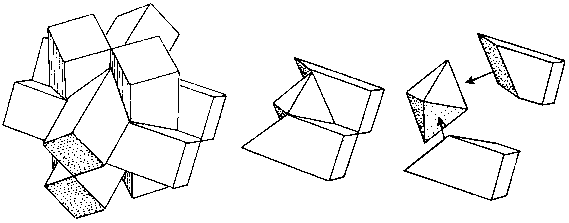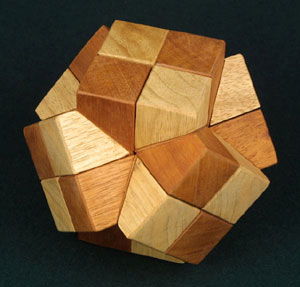
Rightly so or not, the puzzle inventor is often perceived as a fiendish sort whose only purpose is to confuse and frustrate others. Witness the names frequently given to the instruments of the profession - The Devil's Dice, Instant Insanity, The Diabolical Cube, and so on. Anyone who has ever sold puzzles over the counter at craft shows has been asked many times for a puzzle that will drive someone else crazy (usually a close relative!). In this book, I have tried for the most part to present the other side of the coin - geometrical recreations that are fascinating and often challenging, but where confusion is not the ultimate object and deception is not the means to that end. The Pennyhedron Puzzle just described, especially the confusing pair, bears witness to good intentions gone astray. In this chapter, I have purged my files of a few other designs in the same deviant vein.
Readers familiar with the symmetrical version of the diagonal burr puzzle know that the easiest way to disassemble it, especially when it is tight, is to grasp any opposite pair of sticks, wiggle and pull, and the whole thing flies apart. The Pseudo-Notched Sticks Puzzle (Fig. 148) also has six identical pieces and looks exactly like the diagonal burr when assembled. But when you grasp what appear to be two opposite sticks to disassemble it, all you are doing is pressing it ever more tightly together, and it has the feel of being glued absolutely solid! Only when one grasps in a manner that seems to make no sense at all does it come apart with ease!
Fig. 148
Anyone who collects puzzles or writes about them is faced with the question of classification. This design illustrates the sort of problems one confronts. What other field of human endeavor outside of the legal profession is so purposely confusing? If based on superficial appearance, this puzzle would be in Chapter 7, but psychologically it belongs here.
The puzzle shown in Fig. 149 is made by starting with the Pseudo-Notched Sticks Puzzle and adding 12 more notched blocks. Some minor variations are possible, depending upon just where the blocks are attached. The version shown here has six dissimilar, non-symmetrical pieces and two solutions. Note that the addition of the 12 blocks completely changes the appearance of the puzzle so that it now more nearly resembles the Three Pairs Puzzle, even though functionally those two are entirely different.

Fig. 149
Readers are probably familiar with the novelty consisting of two blocks joined together by what looks like a pair of dovetail joints impossible to assemble or disassemble, see Fig. 150. Deceptions of this sort sometimes appear in polyhedral puzzles. One does not expect the Star of David Puzzle to come apart along a diagonal sliding axis. This principle is exploited in the design shown, which has a perfectly prismatic assembled shape but in which the first step of disassembly is a separation into two halves along an unexpected diagonal axis. The construction of these puzzle pieces is similar to that used for the intersecting prism puzzles in Chapter 10, with triangular stick segments attached to six-sided center blocks. The six dissimilar pieces of the version shown are in reflexive pairs. The two end faces are finished true after assembly.
Note that none of the designs described in this book, even in this diabolical chapter, employs concealed locking devices such as hooks, catches, tumblers, or the like. Patent files reveal that one of the preoccupations of puzzle inventors over the years has been to devise such mechanisms, the object being to defeat them and open some secret box or toy bank. Does this fascination with locks and concealment tell us something about ourselves? The number of security devices that one must necessarily deal with in daily life is one of the most discouraging aspects of our civilization. Yet how casually we take them for granted, even turning them into recreations and children's toys!